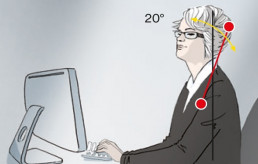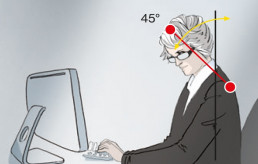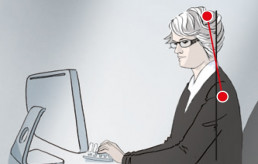Do you really need an extra pair of glasses for your computer? The answer is yes, because the world of work has changed fundamentally. Most of us spend several hours each day in front of a computer. We use them for emails, writing, designing and video conferences. Even after work, we still use google, play games and chat using them.
However, this is in no way a relaxing way to work. Many people who use monitors encounter health problems, such as tension, fatigue and sore eyes. In many cases, it would help those affected to adapt to using a visual aid when working with a computer
Digital eye strain
Working in front of a screen is tough on our eyes. Regardless of whether it is a normal computer, a laptop, a smartphone or a tablet, screens almost exclusively affect where we look and at what distance.
We glance back and forth between the screen and the foreground up to 33,000 times, but almost never look further away. Moreover, when using a screen for hours at a time, we barely move our eyes at all. This puts our eyes under a great deal of strain. Further compounding this are visual display unit reflections and flickers as well as the unpleasant contrast between the foreground and the background.
On any given day, differences in light levels can trigger anywhere between 4,000 and 17,000 pupil reactions. This is all extremely tiring for our eyes. Scientists and doctors call this “digital eye strain”.
Strain-free screen work is possible!
When using a computer, we have to look at lots all at once: the letters on the keyboard, notes on a desk and, of course, the monitor itself. Chatting with colleagues every now and then can also divert our gaze.
Computer glasses are glasses which are designed specifically for working with a computer and as such are tailored for the visual requirements that this involves. The lenses are made to enable clear and strain-free short and mid-range vision. The wearer does not need to adjust their natural head position in any way and their body remains relaxed.
Additionally, computer glasses are so effective in doing this because they are made according to an individual prescription determined by an optometrist. The wearer’s eye movements and their personal working distance are factored in accurately.
Deteriorating visual function
At forty years old, most people start to experience a decrease in their visual function. This is completely natural: age-related long-sightedness (presbyopia) begins to set in – the lenses increasingly lose their elasticity and are less and less able to adjust between different distances. But this doesn’t have to become a hindrance: for most activities, reading glasses or varifocals can help.
However, when working at a computer, reading glasses and varifocals tend to quickly reach their limits: Reading glasses are only suitable for short distance of up to 40 cm, not for the necessary distance of 40-70 cm needed in front of a monitor. Likewise, varifocals are not ideal in this situation either. In varifocals, only a small part of the lens offers the vision correction required for the distance needed when working with a visual display unit.
People who work at a computer while wearing reading glasses or varifocals run the risk of being forced to change their posture in order to see different distances more clearly. This leads to an unnatural posture and health issues. With computer glasses, it is possible to clearly see the screen, keyboard, printouts or people at any time without having to twist and turn one’s neck. Your posture remains relaxed.

With varifocals, the wearer raises their head to be able to see through the small area which adjusts vision for mid-range distances. The neck is tense.

With reading glasses, the wearer tends to lean towards the screen. This puts strain on the back and the neck.

With computer glasses, the wearer has relaxed posture and can see well at all relevant distances.
But computer glasses can do even more
There are also some areas of our day-to-day lives where computer glasses are the perfect visual aid: for example, audit work, handcrafts, painting or reading music, so really for all short-distance activities. In short, where focused vision is required when switching between both short and mid-range distances.
However, they are not suitable for driving as they do not enable clear vision at long distances!
How do I know wether I need computer glasses?
Overall, 80% of people who sit in front of a computer for more than three hours per day complain of discomfort. They get headaches, and dry or even red eyes. They notice that they get tired quickly and become sensitive to light. All of these can indicate that a person requires computer glasses or that their vision is not good enough to be working at a screen.
Tip: Check for yourself: Do you often lean forwards at a computer to get nearer to the monitor? If so, you might benefit from using computer glasses.
Who will bear the costs for computer glasses?
The Health and Safety Regulations Act 1992 states that glasses required for office work are your personal protective equipment at work. This means that employers are obliged to take on at least part of the cost of a pair of computer glasses if presented with the appropriate certification from an ophthalmologist or optometrist. It is always recommended that you speak to your employer in advance. The regulations might differ depending on where you live and work though.